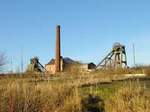

Section under development
Introduction
This section looks at the shaft tops. Both of the shafts were sealed with a concrete cap after they were filled. At the North pit, this concrete shaft cap extends above ground level and there is little to be seen now except for a faint trace of the mine-car rails on the on-loading side.
At the South pit, however, both sides of the shaft had to be trenched to enable conveyors to be used to carry the infill material from the lower level where it was being delivered by lorries and dumper trucks.
As a consequence, the cap is several feet below the pit-top level and for quite a long time a good section of the shaft rim could still be seen. This has since been concealed behind the false shaft walling constructed as part of the restoration works.
No pictures of the early North pit shaft-top at Pleasley Colliery have been found but Teversal was another Stanton Ironworks colliery and a similar scene to this would probably have existed at the North pit at Pleasley.
![Teversall Shaft-top 1989?] Teversall Shaft-top 1989?]](../assets/images/Teversal-pittop-s.JPG)
Teversal colliery downcast shaft-top circa 1914
Unfortunately no pictures of the later shaft-top at the North pit have been located so far.

South shaft top : full-side, Pleasley 1979
In front of the guillotine shaft-doors can be seen a simple safety device designed to prevent accidental movement of mine-cars or other vehicles towards the shaft. It consisted of two steel arms which pivoted so as to allow them to swing away from the shaft only. They would be pushed aside by an off-loading mine-car and then pulled back into position by springs.
At the side of the track, just in front of the safety catch, there was a pneumatic interlock valve with a projecting flexible arm. During normal coal winding operations, this was activated by the off-loading mine-car and it locked decking operations until the mine-car was fully clear of the shaft doors.
NB In this photo, which shows the very last mine car to be raised at the South shaft, the arms are clearly no longer functional, most likely because they were disabled once they were no longer needed after coal winding had ceased after the underground link to Shirebrook Colliery had been created.
The banks-man can be seen to be about to operate a valve used to activate the on-loading pneumatic ram on the far side of the shaft. Under normal coal winding operations, the mine-car in the cage would be pushed off by the on-coming car, but when it was required to clear the cage of a mine-car, such as when it was time to begin man-riding, a long timber joist was used instead.
To do this the banks-man, in his overhead cabin on the empties side of the shaft, turned a switch which locked transferred signalling and pneumatic control to the full side of the shaft. He then descended to track level, placed the joist in place, went round to the full side and rammed the mine-car off from there.
Further details of this and other shaft-side operations will be added as they become available.
Copyright © 2023 J.S. Thatcher
Page updated on:
11 Nov, 2023
at
05:24:42 PM
In case of problems contact: